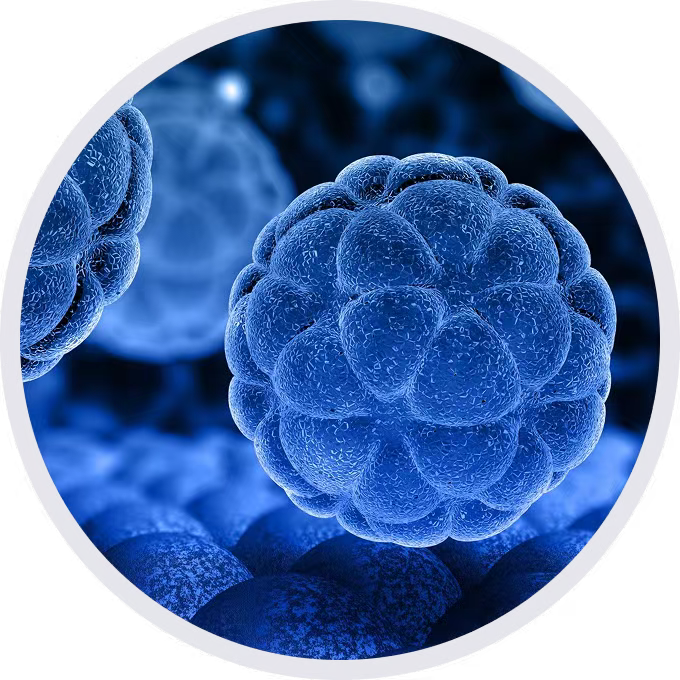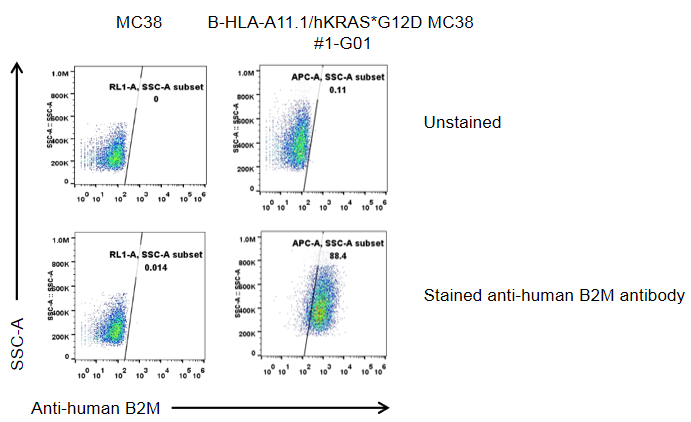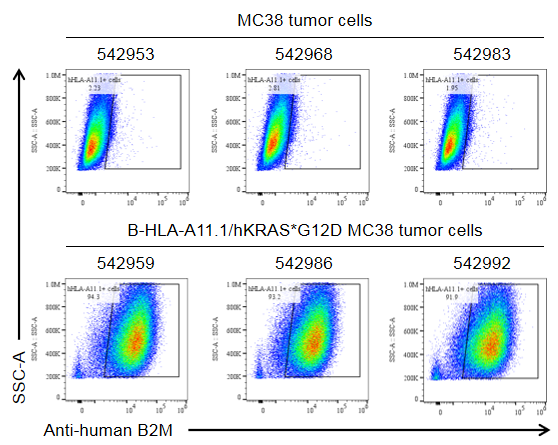
• 322455

| Product name | B-HLA-A11.1/hKRAS*G12D MC38 |
|---|---|
| Catalog number | 322455 |
| Strain background | C57BL/6 |
| NCBI gene ID | 3105,3845 (Human) |
| Aliases | 'C-K-RAS; C-K-RAS; CFC2; K-RAS2A; K-RAS2B; K-RAS4A; K-RAS4B; K-Ras; K-Ras 2; KI-RAS1; KRAS2; NS; NS3; OES; RALD; RASK2; c-Ki-ras; c-Ki-ras2; KRAS; HLAA; HLA-A; KRAS |
| Tissue | Colon |
| Disease | Colon carcinoma |
| Species | Mouse |

Human B2M expression analysis in B-HLA-A11.1/hKRAS*G12D MC38 cells by flow cytometry. Single cell suspensions from wild-type MC38 and B-HLA-A11.1/hKRAS*G12D MC38 cells #1-G01 cultures were detected with species-specific anti-human B2M antibody (Biolegend, 395712). Human B2M was detected on the surface of B-HLA-A11.1/hKRAS*G12D MC38 cells but not wild-type MC38 cells.

Human B2M expression evaluated in B-HLA-A11.1/hKRAS*G12D MC38 tumor cells by flow cytometry. B-HLA-A11.1/hKRAS*G12D MC38 cells were subcutaneously transplanted into B-HLA-A11.1 mice (male, 8-week-old, n=6). Upon conclusion of the experiment, tumor cells were harvested and assessed with species-specific anti-human B2M antibody (Biolegend, 395706). Human B2M was highly expressed on the surface of tumor cells. Therefore, B-HLA-A11.1/hKRAS*G12D MC38 cells can be used for in vivo efficacy studies evaluating cancer vaccines.

Subcutaneous tumor growth of B-HLA-A11.1/hKRAS*G12D MC38. B-HLA-A11.1/hKRAS*G12D MC38 (1×106) and wild-type MC38 cells (5×105) were subcutaneously implanted into B-HLA-A11.1 mice (male, 8-week-old, n=6). Tumor volume and body weight were measured twice a week. (A) Average tumor volume. (B) Body weight. Volume was expressed in mm3 using the formula: V=0.5 × long diameter × short diameter2. Results indicate that B-HLA-A11.1/hKRAS*G12D MC38 cells were able to establish tumors in vivo and can be used for efficacy studies. Values are expressed as mean ± SEM.